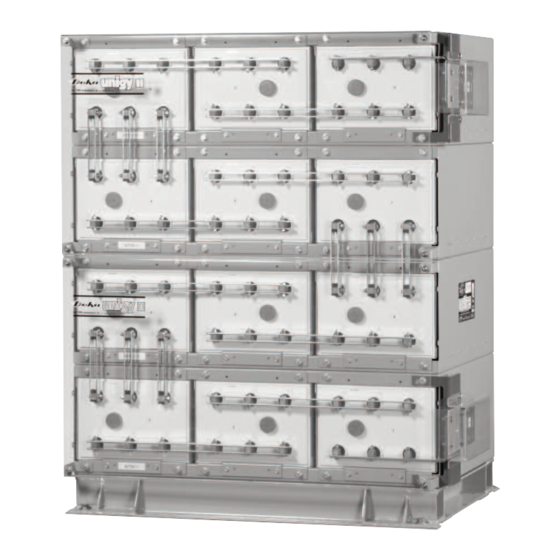
Deka Unigy II Installation And Operation Manual
Nc4-2000 125 ah
Hide thumbs
Also See for Unigy II:
- Installation and operation manual (20 pages) ,
- Installation and operation manual (12 pages) ,
- Installation and operation manual (20 pages)
Table of Contents
Advertisement
Quick Links
®
NEBS CERTIFIED UNIGY II SYSTEM
NC4-2000 125 AH
Installation and Operation Manual
Batteries, battery posts, terminals and related accessories
California
contain lead and lead compounds, and other chemicals known
Proposition 65
to the state of California to cause cancer and birth defects or
Warning:
other reproductive harm. Wash hands after handling.
Advertisement
Table of Contents

Subscribe to Our Youtube Channel
Summary of Contents for Deka Unigy II
- Page 1 ® NEBS CERTIFIED UNIGY II SYSTEM NC4-2000 125 AH Installation and Operation Manual Batteries, battery posts, terminals and related accessories California contain lead and lead compounds, and other chemicals known Proposition 65 to the state of California to cause cancer and birth defects or Warning: other reproductive harm.
-
Page 2: Table Of Contents
Battery Cleaning ..........9 Hardware Torque Requirements ......4 Capacity Testing ..........10 System Installations Sleeve/Cell Removal Procedure ....10 System Shipment ..........4 Unigy II NC4-2000 Module Installation........4-5 Acid Volumes & Weights ......10 Cell Installation ..........5-6 APPENDIX A Electrical Connection BAttERy MAINtENANCE REPORt ..11 Connector Assembly ........6... -
Page 3: Safety Precautions
SAFETY PRECAUTIONS DANGER Although all valve-regulated batteries have the electrolyte HIGH VOLTAGE SHIELD RISK OF SHOCK. immobilized within the cell, the electrical hazard associated EYES. DO NOT TOUCH EXPLOSIVE with batteries still exists. Work performed on these UNINSULATED GASES CAN CAUSE TERMINALS OR batteries should be done with the tools and the protective BLINDNESS OR INJURY. -
Page 4: Installation General
INSTALLATION Module Installation Assemble system per the following details. General All parts should be verified against packaging list. Caution should be taken when installing batteries to insure Report any missing parts. no damage occurs. The battery cabinet, tray, rack, etc. shall 1. -
Page 5: Cell Installation
d. Position lifting device under cell to be removed. 8. Module layout should be compared to system layout diagram and all hardware should be checked for proper Warning: Care should be taken not to have lifting torque before proceeding. Consult “Hardware Torque device come in contact with cells /sleeve assemblies. -
Page 6: Electrical Connection Connector Assembly
2. Safety Shield Brackets are to be installed at the outside require 6 connectors per connection (3 per side). Tighten corners of every 2 modules starting from the bottom and & torque all bolts after all connectors are installed. working towards the top. Use 3/8-16 x 1.25 hardware to Consult “Hardware Torque Requirements”... - Page 7 Complete Assembly Side Terminal Assembly 6. Top terminal plate designed to use up to 0.50 dia. bolt 9. Side Terminal Plate is designed to use up to 0.50 dia. and a maximum 1.75 centers, 2 hole lug. Lug hardware bolt and a maximum 1.75 centers, 2 hole lug. Plate is not included.
-
Page 8: Final Assembly Check Procedure
Final Assembly Check Procedure 3 One shield will cover two modules. Hang the first shield on the top brackets through the large part of the keyhole. 1. For future identification of all cells, number individual At the same time aligning the cutout at the bottom of the cells in sequence, beginning with number one (1) at the shield with the second set of brackets. -
Page 9: Operating Temperatures
Operating Temperatures 6. Individual cell ohmic readings. For 6-post cells, measure from center positive to center negative posts. Do not Battery Temperature Float Voltage per Cell measure diagonally from positive to negative posts. See °F °C ± .01 volts below page for specific location. 50˚... -
Page 10: Capacity Testing
Capacity Testing Capacity tests should not be run unless the battery’s operation is questionable. Do not discharge the batteries beyond the specified final voltage. When discharging at higher rates, extra connectors may need to be added to pre- vent excessive voltage drop. When performing capacity test- ing and recording data use IEEE 1188 instructions. -
Page 11: Battery Maintenance Report
APPENDIX A BAttERy MAINtENANCE REPORt date ______________________ Company ____________________________________________________________________________________________ Address______________________________________________________________________________________________ Battery Location and/or number ____________________________________________________________________________ no. of Cells ________ Type________________________________ date Mfg.____________ date Installed____________ Charger Output__________________________ Ambient Air Temperature ______________________°F Total Battery Voltage _________________ Panel Meter Volts ___________________ Installer___________________________________________________ INDIVIDUAL CELL READINgS Cell Cell Cell... - Page 12 ® “ P O W E R E D F O R P E R F O R M N C E DIStRIBUtED By: Lyon Station, PA 19536-0147 • Phone: 610-682-6361 • Fax: 610-682-4781 Order Department Hotline: 610-682-4231 www.eastpennunigy.com • E-mail: sales@eastpennunigy.com No part of this document may be copied or reproduced, electronically E.P.M.








Need help?
Do you have a question about the Unigy II and is the answer not in the manual?
Questions and answers